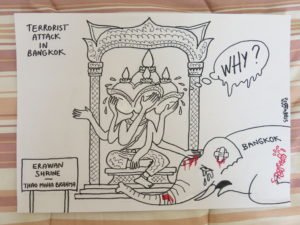Siam Discovery to be revamped into an ‘Exploratorium’
Another news item from the Explore and Discover Thailand blog at Thailand Discovery
THE NEWLY MADE-OVER SHOPPING MALL RETURNS IN THE SECOND QUARTER WITH A “FACELESS” CONCEPT THAT INVITES EXPLORATION
THREE YEARS after Siam Discovery Center metamorphosed from Bangkok’s oldest shopping mall into a sparkling and high- tech Ideapolis, its sister mall Siam Discovery is being reincarnated with a “naked” and “faceless” expression.
Breaking all conventional retailing rules, the overhaul will see the 18-yearold mall reopened without a single retail shop in the 40,000 square metre space. The facade is glass, the floor is open plan and the products are not organised by categories and brands, but through story-telling components.
“Everything is completely changed. We have stripped off our clothes and become faceless so that we can be friends with everyone without boundaries,” says Chadatip Chutrakul, chief executive of Siam Piwat, which also operates Siam Paragon and Siam Center.
“We’re calling our place the ‘Exploratorium’ – a lifestyle lab where visitors are drawn into ‘stories’ with an ‘emotional experience’ relevant to their styles, interests, beliefs, and trends rather than just being presented with a selection of products. We have chosen to replace the rental system and not have tenants but manage the total space by ourselves.”
With “stories” and “emotional experiences” playing the key roles in the new Siam Discovery, Chadatip needed a talented “storyteller” for the Bt4billion rejuvenation. The obvious choice was the Japanese design studio Nendo whose diverse portfolio encompasses works of architecture, graphic design, interiors, furniture and products that are minimal but full of narratives and witty ideas.
One of the most sought-after design firms in Asia, Nendo was awarded the Designer of the Year title for the 2015 Maison & Objet trade fair in Paris. Its well-known designs include a series of wooden tables based on characters from Winnie the Pooh for Walt Disney Japan, a chair made out of pleated paper waste for Issey Miyake, a chocolate pencil with a sharpener for making shavings for Tokyo patissier Tsujiguchi Hironobu, as well as the interiors for various Camper, Puma, Starbucks and Kenzo stores.
“This is my first project in Thailand and in terms of scale, it’s largest I’ve ever done. I’ve always worked on a small plate of food, but this is a fullcourse menu. If Siam Piwat is a dream factory, my task is to find the right chemistry that will ensure people with different lifestyles and cultures discover, explore and are inspired,” says Oki Sato who founded Nendo in 2002 after earning a master’s degree in architecture from Tokyo’s Waseda University.
The new design concept has been two years in the making and is designed to respond to the lifestyles of contemporary folk who, Chadatip says, are engaged in the interactive community, prefer personalised purchases, are immersed in digital and innovative technology, and look for values in products rather than just the brand name.
“It took more than a year of discussion with entrepreneurs and suppliers to impart the idea that we won’t be selling your brand but the story of your product. The inspiration behind the product, the painstaking process of production and the sustainable materials are among the stories or values that will be at the fore. This is a pioneering concept that blends interactive retailing with hybrid mixes across brands and categories for visitors to discover, define and create their own distinct and personal style. This concept is flexible and responds promptly to the ever-changing needs of customers,” Chadatip says.
Sato, who is acting as the chief consultant for the building and interior design, has teamed up with local firm Urban Architect, the company behind the success of Siam Center’s major facelift.
“In the age of the Internet where you can get information and everything you need with a single click, I had to ask myself why we need a retail space at all. My idea is to create the ‘experience’ and ‘emotion’ of a comfort zone that you can’t get from e-commerce. I started by planting small seeds of ideas throughout the huge open-plan space. Each is a small story in itself. It can be the lighting, the material, or simply the proportion of a certain object that relates to people’s emotions while creating a link between them, the object and the venue,” says the 39-year-old Sato, who was named among the “100 Most Respected Japanese” by
Newsweek Magazine in 2006. “I like to design things that don’t need to look cool. I try to think about small things that people have probably experienced in the past but forgotten. When they see a new design embedded with a hidden story, they feel a link. I know that feeling. It’s about noticing small moments in everyday life.”
In Japanese, Nendo means “play dough” and is a reflection of Sato’s design philosophy that focuses on flexibility and changing shapes, sizes and colours all with a sense of sentiment, humour, wit and friendliness.
In the winter of 2014, the designer created a collection of Village ice cream cakes for sale in the Champs Elysees Haagen-Dazs shop in Paris to remind people about homecoming. Sitting on top of the white ice cream base was a cluster of small chocolate houses, with their rooftops dusted with white chocolate powder to look like snow.
For Disney, he created colourful knitted covers for the Pooh Table collection of maple wood furniture so the designs represented the famous yellow bear and his companions. The largest table had a red knit covering a shelf beneath the tabletop similar to the sweater worn by Pooh while his friend Piglet was represented as a side table wearing a purple sleeve across most of its top.
“I’m a design otaku. As a designer, you have to really love design,” says Sato who is currently working on about 400 different projects.
Original article from The Nation March 6th 2016
